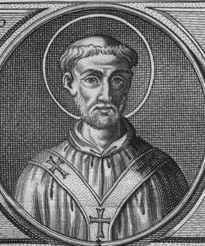Saint of the Day Online - St Gelasius
Saint of the day online, Monday, November 21, 2017
21-11-2017
St Gelasius who was the Pope from 1 March 492 to his death in 496 was probably the third and last Bishop of Rome of Berber descent in the Catholic Church.
Gelasius had a reputation for learning, justice, holiness, and charity. However, he was burdened with difficulties caused by a conflict with Euphemius, the Patriarch of Constantinople, over the Acacian heresy. He also protested the encroachments by Constantinople on Alexandria and Antioch.
Gelasius' election on 1 March 492 was a gesture for continuity: Gelasius inherited Felix's struggles with Eastern Roman Emperor Anastasius and the patriarch of Constantinople and exacerbated them by insisting on the removal of the name of the late Acacius, patriarch of Constantinople, from the diptychs, in spite of every ecumenical gesture by the current, otherwise quite orthodox patriarch Euphemius (q.v. for details of the Acacian schism).
The split with the emperor and the patriarch of Constantinople was inevitable, from the western point of view, because they had embraced a view of a single, Divine ("Monophysite") nature of Christ, which was a Christian heresy according to the Church of Rome. Gelasius' book De duabus in Christo naturis ("On the dual nature of Christ") delineated the Western view. Thus Gelasius, for all the conservative Latinity of his writing style, stood on the cusp of Late Antiquity and the Early Middle Ages.
Gelasius is known to have composed liturgical Prefaces and Orations for Sacramentaries, which may be part of the Leonine Sacramentary. However, he had nothing to do with the Gelasian Sacramentary or the Gelasian Decree (listing the Canonical books of the Bible) - which have been erroneously attributed to him. He died at Rome on November 21, 496.